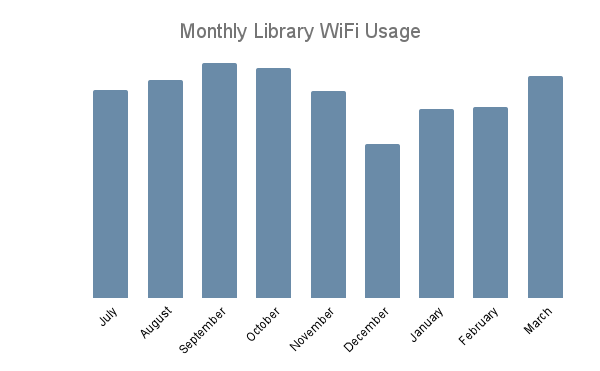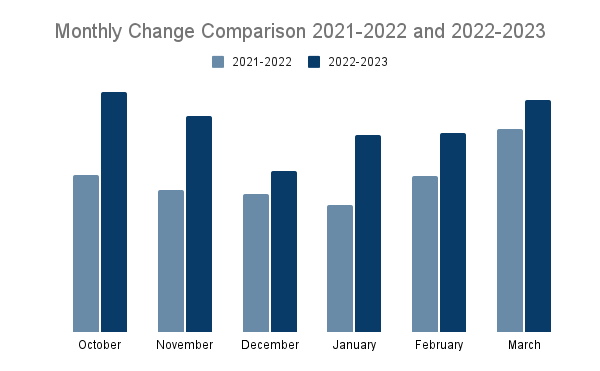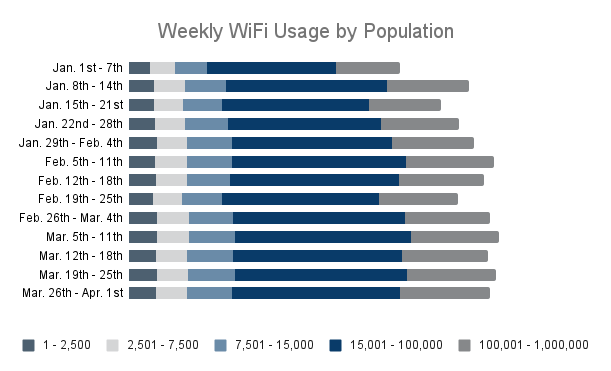Public Library WiFi Usage Q1 2023
First Quarter 2023 Sees Rise in Public Library WiFi Use
The latest data on public library WiFi usage indicates a steady increase in usage during the first quarter of 2023, with libraries working diligently to advance digital equity in their communities. This article explores the potential implications of this trend, from the benefits for patrons and libraries to what the future of public library WiFi may hold. Reliable high speed internet is a critical service offering and one that communities increasingly depend on public libraries to provide.
Monthly Library WiFi Usage – July to March
According to the latest data, there has been a steady increase in monthly library WiFi usage over the last nine months with seasonal decreases where they might be expected. This trend could indicate increasing reliance on digital access, as well as the crucial role that public libraries play in closing the digital divide. Since the onset of the COVID-19 pandemic libraries have become vital community hubs for individuals who may not have access to reliable internet. The rise in monthly library WiFi usage shows that libraries’ missions to provide equitable access to information and technology are well underway.
Comparing Results From Previous Years
The beginning of 2023 saw a steady increase in usage with a faster return of patronage in January 2023 than January 2022. While there was already a steady increase in usage, the greater increase could be attributed to fears surrounding variants of the COVID-19 pandemic that were prevalent in the beginning of 2022. The growing number of patrons using library WiFi is proof that the high speed WiFi libraries provide is an increasingly valuable investment in the community. This trend is likely to continue as libraries further invest in their digital infrastructure and adapt to changing community needs.
Digital Equity Being Advanced By Libraries
As more essential services in education, work, and healthcare move online, access to high speed internet has become increasingly crucial. However, not everyone has equal access to digital resources, leading to a digital divide that can have serious consequences. Fortunately, public libraries have recognized this issue and have been working to bridge the gap. By providing free high speed WiFi access to their patrons, libraries are taking a critical step in advancing digital equity in their communities.
The increase in public library WiFi use is a direct indication that libraries are addressing the issue of digital divide head-on. As states prepare their 5 year plans for the BEAD (Broadband Equity, Access, and Deployment) program funding libraries continue to adapt to changing community needs, we can expect this trend to continue with a significant impact on digital equity. It is no wonder that the NTIA has recommended that states partner with community anchors like libraries to help educate and support communities as stronger and more affordable broadband connections become available.
With public libraries playing an essential role in bridging the digital divide, we will continue to monitor progress to see what the future holds for libraries and this massive $42.5 billion program.
Steady Growth in 2023
Public libraries have been working hard to narrow the digital divide that exists in many communities. As a result, there has been a steady growth in public library WiFi usage in the first quarter of 2023. This growth reinforces the vital role that public libraries play in promoting digital equity across the United States.
As public libraries offer free access to the internet and digital resources, they have become a lifeline for many people who cannot afford these services. Libraries have also been providing digital literacy programs to help patrons improve their digital skills.
Libraries are also benefiting from this rise in WiFi usage. By offering free and reliable WiFi, libraries help to strengthen their role in the community as an essential source of information and learning. This, in turn, has attracted more patrons and encourages partnerships and funding bodies for these vital institutions.
What Does the Future Hold for Public Library WiFi?
Looking into the future, it’s clear that public library WiFi will remain a crucial component of the modern library. With more and more patrons relying on smartphones, tablets, and laptops for work, education, and entertainment, libraries must continue to provide reliable and high-speed WiFi to meet the needs of their users.
New federal funding from the NTIA should positively impact public library WiFi usage in years to come as libraries are tapped to aid in education and support for new broadband deployments in their communities. However much remains to be seen. Having a standardized way to collect and report this information will allow libraries to easily quantify the impact over time and be a useful tool in future advocacy efforts. In addition to partnering with their states in goals to get communities connected, many libraries are implementing other digital initiatives, such as offering digital media collections, online classes, and computer literacy programs.
Overall, the future of public library WiFi is strong. As technology and federal broadband infrastructure continues to evolve, libraries continue to adapt and innovate to ensure that their patrons have access and training on the latest digital resources and tools. By embracing this ongoing challenge, libraries will continue to play a vital role in the lives of their patrons.
Visit whofi.com/demo to schedule a time to review your library goals and priorities surrounding data and storytelling.




